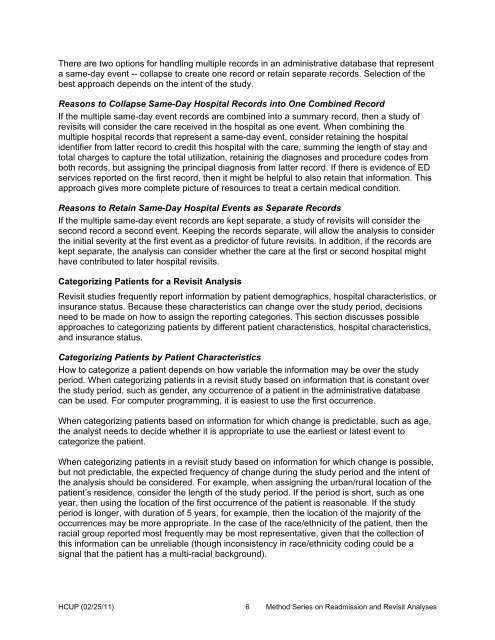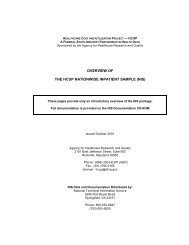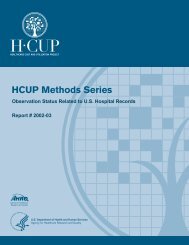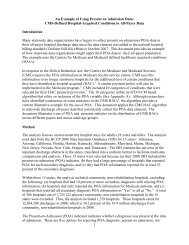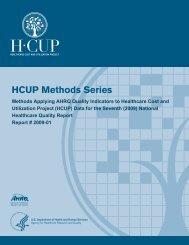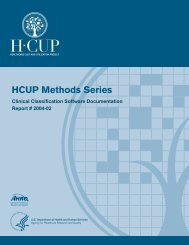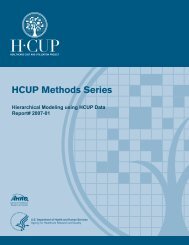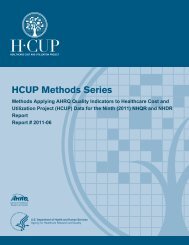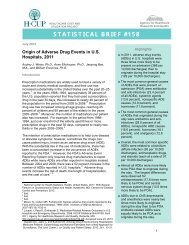Methodological Issues when Studying Readmissions and ... - HCUP
Methodological Issues when Studying Readmissions and ... - HCUP
Methodological Issues when Studying Readmissions and ... - HCUP
You also want an ePaper? Increase the reach of your titles
YUMPU automatically turns print PDFs into web optimized ePapers that Google loves.
There are two options for h<strong>and</strong>ling multiple records in an administrative database that representa same-day event -- collapse to create one record or retain separate records. Selection of thebest approach depends on the intent of the study.Reasons to Collapse Same-Day Hospital Records into One Combined RecordIf the multiple same-day event records are combined into a summary record, then a study ofrevisits will consider the care received in the hospital as one event. When combining themultiple hospital records that represent a same-day event, consider retaining the hospitalidentifier from latter record to credit this hospital with the care, summing the length of stay <strong>and</strong>total charges to capture the total utilization, retaining the diagnoses <strong>and</strong> procedure codes fromboth records, but assigning the principal diagnosis from latter record. If there is evidence of EDservices reported on the first record, then it might be helpful to also retain that information. Thisapproach gives more complete picture of resources to treat a certain medical condition.Reasons to Retain Same-Day Hospital Events as Separate RecordsIf the multiple same-day event records are kept separate, a study of revisits will consider thesecond record a second event. Keeping the records separate, will allow the analysis to considerthe initial severity at the first event as a predictor of future revisits. In addition, if the records arekept separate, the analysis can consider whether the care at the first or second hospital mighthave contributed to later hospital revisits.Categorizing Patients for a Revisit AnalysisRevisit studies frequently report information by patient demographics, hospital characteristics, orinsurance status. Because these characteristics can change over the study period, decisionsneed to be made on how to assign the reporting categories. This section discusses possibleapproaches to categorizing patients by different patient characteristics, hospital characteristics,<strong>and</strong> insurance status.Categorizing Patients by Patient CharacteristicsHow to categorize a patient depends on how variable the information may be over the studyperiod. When categorizing patients in a revisit study based on information that is constant overthe study period, such as gender, any occurrence of a patient in the administrative databasecan be used. For computer programming, it is easiest to use the first occurrence.When categorizing patients based on information for which change is predictable, such as age,the analyst needs to decide whether it is appropriate to use the earliest or latest event tocategorize the patient.When categorizing patients in a revisit study based on information for which change is possible,but not predictable, the expected frequency of change during the study period <strong>and</strong> the intent ofthe analysis should be considered. For example, <strong>when</strong> assigning the urban/rural location of thepatient’s residence, consider the length of the study period. If the period is short, such as oneyear, then using the location of the first occurrence of the patient is reasonable. If the studyperiod is longer, with duration of 5 years, for example, then the location of the majority of theoccurrences may be more appropriate. In the case of the race/ethnicity of the patient, then theracial group reported most frequently may be most representative, given that the collection ofthis information can be unreliable (though inconsistency in race/ethnicity coding could be asignal that the patient has a multi-racial background).<strong>HCUP</strong> (02/25/11)6Method Series on Readmission <strong>and</strong> Revisit Analyses


